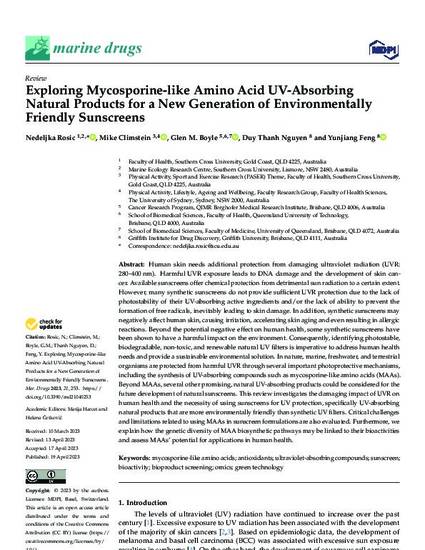
Article
#1_marinedrugs-21-00253 PUBLISHED April 2023.pdf
Marine Drugs
(2023)
Abstract
Human skin needs additional protection from damaging ultraviolet radiation (UVR:
280–400 nm). Harmful UVR exposure leads to DNA damage and the development of skin cancer.
Available sunscreens offer chemical protection from detrimental sun radiation to a certain extent.
However, many synthetic sunscreens do not provide sufficient UVR protection due to the lack of
photostability of their UV-absorbing active ingredients and/or the lack of ability to prevent the
formation of free radicals, inevitably leading to skin damage. In addition, synthetic sunscreens may
negatively affect human skin, causing irritation, accelerating skin aging and even resulting in allergic
reactions. Beyond the potential negative effect on human health, some synthetic sunscreens have
been shown to have a harmful impact on the environment. Consequently, identifying photostable,
biodegradable, non-toxic, and renewable natural UV filters is imperative to address human health
needs and provide a sustainable environmental solution. In nature, marine, freshwater, and terrestrial
organisms are protected from harmful UVR through several important photoprotective mechanisms,
including the synthesis of UV-absorbing compounds such as mycosporine-like amino acids (MAAs).
Beyond MAAs, several other promising, natural UV-absorbing products could be considered for the
future development of natural sunscreens. This review investigates the damaging impact of UVR on
human health and the necessity of using sunscreens for UV protection, specifically UV-absorbing
natural products that are more environmentally friendly than synthetic UV filters. Critical challenges
and limitations related to using MAAs in sunscreen formulations are also evaluated. Furthermore, we
explain how the genetic diversity of MAA biosynthetic pathways may be linked to their bioactivities
and assess MAAs’ potential for applications in human health.
Keywords
- mycosporine-like amino acids;,
- antioxidants,
- ultraviolet-absorbing compounds,
- sunscreen,
- bioactivity,
- Biproduct screening,
- omics,
- green technology
Disciplines
Publication Date
April, 2023
DOI
doi.org/10.3390/md21040253
Citation Information
Nedeljka Rosic, Mike Climstein, Glen M Boyle, Duy Thanh Nguyen, et al.. "#1_marinedrugs-21-00253 PUBLISHED April 2023.pdf" Marine Drugs Vol. 21 Iss. 4 (2023) p. 1 - 18 ISSN: ISSN 1660-3397 Available at: http://works.bepress.com/michael_climstein/187/
